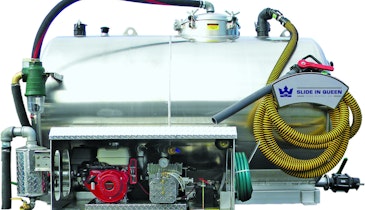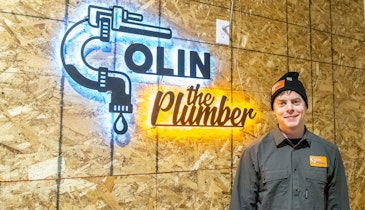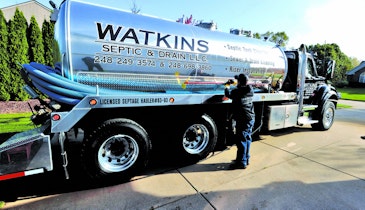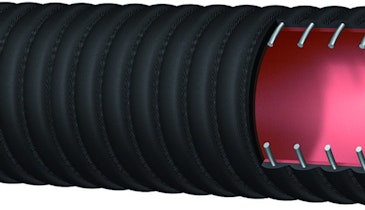With General Motors backing out of the medium-duty truck business, Sterling no longer an active brand and Isuzu’s F-Series on hold, pumpers might question what chassis choices will remain when it’s time to purchase a new vacuum truck for septic service. The answer: plenty.
From the 33,000 GVWR Hino 338 Series to the beefy Peterbilt Class 8 365/367, there’s a make and model to meet most any need. While continued shrinkage of the industry is possible, current brands Western Star, International, Mack, Freightliner, Kenworth, Ford and Volvo remain.
Of greater concern to truckbuilders are the effects added emissions requirements might have on the placement of PTOs, pumps, tool boxes and other accessories. With tougher standards in 2010, builders wonder if they will face even greater space challenges as manufacturers opt for selective catalytic reduction (SCR) technology to trim emissions. The one exception is Navistar and its International brand, which offers what it calls “hassle-free MaxxForce Advanced EGR technology” that does not require the diesel exhaust fluid (DEF) made from the liquid ammonia compound urea.
Toby Jones, sales manager for Canada’s Transway Systems Inc. of Hamilton, Ontario, says International and Peterbilt are among his customers’ most popular chassis choices. “The International has a good quality product at a good price and they have a large footprint all over the world,” he says. “There aren’t too many places that don’t have an International dealer.
“Peterbilt is more of a truck you’re going to sell to Americans; for whatever reason they love their Petes. The Pete 340 is what we call a Baby 8. It’s a 58,000 GVW vehicle. Max horsepower goes to 330, which for some guys is a little low,’’ Jones continues. “International has basically owned that market for years and years and years, but the Freightliner M2 Series and the Peterbilt 335 and 340 have kind of infiltrated that market and done very well.”
EMMISSIONS CONCERNS
Jones says he hasn’t heard of problems resulting from the 2007 engine emission regulations. “I haven’t had a DPF (diesel particulate filter) issue or anything like that,” he says. “I haven’t heard of any problems from any of my customers. Not one.”
That’s not the case, however, for Jerry Kirkpatrick, vice president of Arizona-based Glendale Welding Co., whose customers say that 2007-emission engines aren’t lasting as long.
“This is just customers I have dealt with over the years,” he says. “Before they were getting 300,000 and 400,000 miles; now all of a sudden they’re popping and blowing engines at 77,000. I think with the new emissions and the new regeneration system, they hurt the truck. I think the more emissions (equipment) they put on it, they’re going to kill the diesel engine.”
Kirkpatrick says another issue is the way emission equipment has limited builders.
PUMP PLACEMENT
“When we’re doing a pump system, if a customer wanted it on the driver’s side or passenger side, before this emissions came out, you could move the exhaust out of the way and put the pump where he wanted it. But now you void the warranty on the emission system. So if the emission system is on the right side, you got to put the pump on the left side. The manufacturer determines for the builder what side he can put your pump on.” There’s also the issue of how close items can be mounted to the collector. “It gets so hot, so you’ve got to watch so you don’t burn up the tool boxes.”
Tom Aerts, general sales manager for Imperial Industries Inc. in Rothschild, Wis., agrees.
“With everything being on the passenger side, the location of all the equipment to meet the emissions — the afterburners and everything else — it takes away that passenger side PTO. It also takes out capacity — you lose capacity on the passenger-side for tool boxes, for jetters, for alternative sources of equipment that we were used to mounting there. You can’t do it,” he explains.
“So now you’ve got to find a way to either go without, re-devise or go with gas engines. There are a lot of variables that play with each unit — what you can put on and what you can’t.” Aerts predicts the problem will only grow as more emissions equipment is added.
Brian Stroetz with V & H Inc. vacuum truck sales in Marshfield, Wis., dealer for Sterling and Western Star, says reliability issues can be expected with any new technology.
“It’s still evolving and there might be some issues, but I don’t think it’s been a problem with any one engine manufacturer,” he says. “They seem to be, overall, doing a pretty good job. They’ve all had their bugs to work through. But, overall, I think it’s OK. And if you have good dealer support, they’ll make sure you’re up and running right away.”
One possible concern is what to do with the particulate filter when it fills up. Stroetz says engine manufacturers are working to establish an exchange program where truck owners can take their filter, exchange it for another and be back on the road.
“You won’t necessarily get your filter back. You’ll get someone else’s, but that’s not a problem. They’ll go by engine manufacturer.”
A CLEANER ENVIRONMENT
One positive of the 2007 requirements has been cleaner burning engines, Stroetz says. “There’s no doubt about it. They do run cleaner. We’ve had all manufacturers’ brands that we work on, and we have seen that they are definitely running cleaner; the exhaust pipes are clean on the inside — they’re not all full of black soot. So they are doing what they said they would do. They’re cleaning up the atmosphere.”
Another positive, says Stroetz, is better fuel mileage anticipated with the 2010-model engines. “They went down a little bit in the last round in ’07; now in 2010 that should come back up. This should help larger fleets in particular,” he says.
When it comes to selecting a make or model truck, Stroetz says it often comes down to personal preference and dealer performance.
“A lot of it comes down to service,’’ Stroetz says. “Some guys will say, ‘I don’t care what brand name is on the front of the hood, I’m going to get whatever I can get serviced.’ ”
If you happen to be the owner of a Sterling truck or are considering purchasing a remaining unit from the end of production, Stroetz says parts and maintenance should not be an issue.
“The Sterling brand’s parent company is Mercedes-Benz and the Freightliner Truck Corp., and they’re still going to have parts and service available for at least 10 years down the road. It’s not like they were a stand-alone company that went out of business. They were part of a larger group with Western Star, Freightliner and Daimler.”
There also are discounts and incentives on remaining Sterling trucks, although features such as air-ride suspension and automatic transmissions are becoming harder to find, he says.
SALES SPIKE UNLIKELY
Steve Nelson, owner of Tank Tec Technologies & Supply Co. LLC in Minneapolis, doesn’t anticipate another buying frenzy like the one that preceded the 2007 emissions rules. “I think we’re just going to poke along and do our thing,” he says. “The latest estimates I’ve seen is we’re not going to get new emissions engines into production until about April.”
Nelson believes the new regulations might cause some truck owners to pause, but they won’t accelerate purchases like they did the first time around. “And I think that’s only because of the economy being where it is,” he says.
And there doesn’t appear to be much interest in hybrids among vacuum truck owners. “That’s because this industry is more of a mom and pop type,” Stroetz says. “If you were a big corporation that had 500 trucks running up and down the road, that’s a different story. But septic companies generally have one truck and they stay very local. Most of them don’t go more than 20 miles from their home. The hybrids just aren’t something they’re in need of.”
That’s also been the experience of Bill Abernethy, owner of Abernethy Welding & Repair Inc. in Vale, N.C. “I haven’t had a call for one (hybrid). I think it would be a good thing, but I haven’t seen one,” he says.





